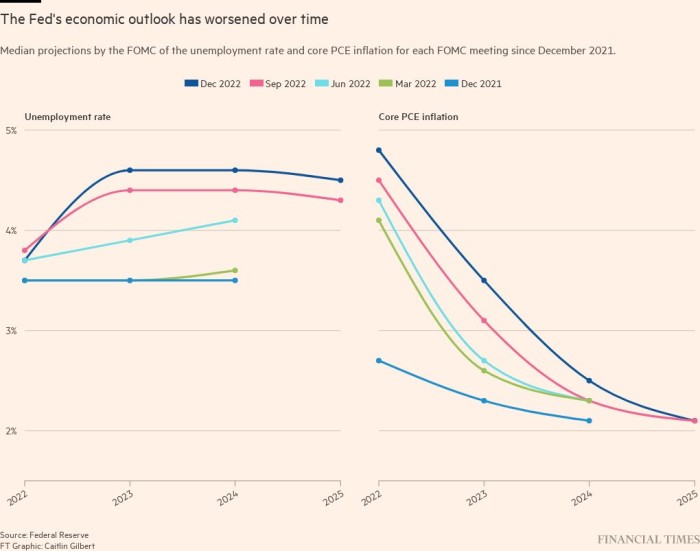As Federal Reserve officials prepared to kick off their final policy meeting of 2022 on Tuesday, they received some welcome news: inflation, which has been running at multi-decade highs for more than a year, fell decisively in November.
The better than expected data, which followed a moderation in October, sparked hopes the Fed might not have to inflict as much damage on the economy to bring inflation back down to its 2 per cent target.
But if Fed chair Jay Powell was relieved, he did not show it when he addressed reporters at the conclusion of the gathering on Wednesday. Even as the US central bank slowed the pace of rate rises — shifting to a half-point increase after a string of 0.75 percentage point rises — he warned the job was far from done.
In fact, Powell said officials might still need to take harsher action to damp economic demand to a level that would root out the price pressures proving hardest to shift.
For any let-up in the fight against rising prices, the Fed would need to see “substantially more evidence” that inflation is abating, Powell said at the press conference after the central bank lifted the federal funds rate to a new target range of 4.25 per cent and 4.50 per cent.
He added: “My view and my colleagues’ view is that this will take some time . . . It’s good to see progress, but let’s just understand we have a long way to go to get back to price stability.”
Rick Rieder, BlackRock’s chief investment officer of global fixed income, described Powell’s message as “almost a dismissal” of the recent improvements in inflation. It was aimed at those investors who believe the Fed will lose its nerve next year and abandon its fight against high prices as job losses mount and the economy tips into a recession.
The idea that the Fed will eventually balk as the impact of its tightening campaign become more apparent in the real economy has led to a substantial loosening of financial conditions: in recent weeks, stocks have rallied, borrowing costs have declined and mortgage rates have fallen from their recent peaks. In aggregate, the moves undid some of work the Fed did to put a lid on demand.
Powell warned it was “important” for financial conditions to align with the Fed’s intentions and repeatedly stated the central bank’s main concern was high inflation that had to be tackled with higher rates for longer. He even dismissed investors pricing in two rate cuts by the end of next year.
Vincent Reinhart, who worked at the Fed for more than 20 years, said Powell needed tighter financial conditions to bring demand into better alignment with supply and thus tame inflation.
But Reinhart, now at, Dreyfus Mellon warned Powell would be unable to push up borrowing costs sufficiently “if investors are more optimistic about the path for rates in the near-term”.
He added: “So he has to downplay any good news on inflation, emphasise the hard work that has yet to be done, and emphasise the pain that will be inflicted.”
The Fed sent a clear signal of more such pain to come on Wednesday with a new set of economic projections that showed the benchmark rate hitting a higher level than previously projected and sitting at that threshold for an extended period. Meanwhile growth will be slower and unemployment higher, the forecasts suggest.
Most officials now see the fed funds rate topping out at 5.1 per cent, with a large cohort of the view that it may need to exceed 5.25 per cent. Powell also warned that he could not “confidently” say the Fed would not again move up its estimates.
Rate cuts are not expected until 2024, when the benchmark rate is projected to decline to 4.1 per cent before falling to 3.1 per cent in 2025.
Despite these upward revisions, traders in fed funds futures markets are still wagering the Fed will halt its tightening campaign before the rate hits 5 per cent and deliver cuts by the end of next year.
“What the market does not have right now is patience of any kind,” said Elaine Stokes, a portfolio manager at Loomis Sayles & Company. “They want this thing over and to be through this cycle by the end of next year.”
Daleep Singh, a former economic adviser to the Biden administration and ex-New York Fed official, said he still thought there was a chance for the central bank to change tact next year and embrace the recent improvement in inflation data.
“People always say that one data point is not a trend, but two data points you have to take seriously,” said Singh, now chief global economist at PGIM Fixed Income. “But if we’re in January and we see a third-consecutive friendly inflation print, then I think Powell would need to make a shift in the signalling.”
“In the meantime, he just wanted to keep markets sober and to avoid spiking the punchbowl,” Singh added.
Additional reporting by Kate Duguid in New York







